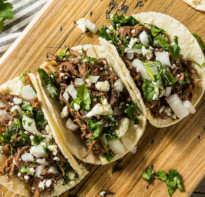
- Class: Standard Taco (Traditionally corn but often with Flour)
- Origin : Texcoco Mexico
- Protein : Beef (traditional) or Lamb occassionally
- Meat Cut: Beef Cheek
- Similar to :Incredibly tender yet slightly fatty pot roast
- Prepared: Simmered on low heat for several hours
- Served : Pulled or lightly chopped
- Menu-Availibility: Common USA / Common Mexico
- Flavor Profile : Seared, Tender, Seasoned & Succulent
- Flavor Rating (1-10) : 9
- Appeal Rating (1-10) : 9
- Thoughts : Fore barer of traditional BBQ in USA
- Final Words : "A poweful taco that doesnt disappoint"
Each region of Mexico has its particular way of making barbacoa -- the variations are endless, from the type of meat used and the type of condiments to the material used for wrapping the meat and even the baking or steaming process itself.
Traditionally in Mexico, barbacoa is made with lamb (though you’ll also see it made with beef or goat) that is wrapped meat in maguey (aka agave) leaves then slow-roasted overnight in an underground oven lined with hot stones.This dish is a Mexico City street food staple on the weekends where, as early as 8 AM, you can get your hands on barbacoa as tacos or served with consommé –– a soup made from the meat drippings and mixed with garbanzo beans and rice.
Barbacoa is believed to have originated centuries ago in Barbados, an island country in the West Antilles of the Caribbean. The word “barbados” is derived from the words “Los Barbadoes” meaning “the bearded ones,” a name created by 16th century Portuguese explorers to describe giant bearded fig trees covering many Caribbean islands.
It is widely believed the West Indies native Taino people, a subgroup of the South American Arawaks, first used green, fire-resistant bearded fig branches for cooking. They marinated foods in tropical herbs and spices to enhance natural flavors and preserve them after cooking. The Tainos called their preparations “barabicu,” or “sacred firepit,” that over time became “barbecue.” These cooking methods were superb at keeping their foods from prematurely spoiling.
The Barbacoa style of cooking was eventually taken to Mexico, where it still refers to meats slow-roasted over an open fire, or more traditionally, in a fire pit covered with succulent leaves of the maguey plant (also known as agave or century plant.)
Mexico’s original Barbacoa used the country’s many and varied molés (pronounced “mol-ehs”) and salsas, the first barbecue sauces. Molé is a complex, rich thick sauce, used to accompany meats. It is made from a variety of chiles, onions, garlic, cumin, coriander, cinnamon, cloves, sesame seeds, several types of nuts and a small amount of chocolate, the best-known ingredient, which contributes richness to the sauce without adding much sweetness. Traditionally, game, turkey, and fish, along with beans and other side dishes, were slow cooked in a pit for many hours. Following the introduction of cattle, pigs, goats, sheep, and chickens by the Spanish, the meat of these animals was also prepared in the traditional indigenous style.
Along the roads in Texcoco, a rural area approximately 15 miles east of Mexico City, Barbacoa stands and small restaurants serve this favorite food. The region is generally recognized as the home of barbacoa in Mexico.
The large food court of the tianguis (public market) of Texcoco in the state of Mexico, outside of Mexico City, seats hundreds of diners who are served barbacoa de borrego (lamb barbecue) and other regional specialties by dozens of open-air restaurants.
Barbacoa is an ancient style of BBQ to be put simply. The oldest known use of it was by the Aztec. They would dig a deep hole in the earth and build a fire of very hot coals, line it with agave leaves and slow roast (almost steam) small game meats, birds and sometimes fish. They would cover the top tightly with more agave leaves, cover it up and let it cook all day, sometimes overnight.
More Information
Grandma's recipe Barbacoa Tacos at home
Barbacoa - Done Old School
Envisioning a world powered by Tacos of every kind
Subscribe to our news letter for weekly taco insights and reviews as we favorful examples of Taco culture. Join us as we search the globe for outstanding examples of Taco culture and eat a lot of tacos
POPULAR TAGS
Texas Tacos Best Taco Spots Tacos Carnitas Birria San Antonio Tacos Suadero Barbacoa Al Pastor Tinga Puffy Tacos Taco Culture Cochinita Pibil Chilaquiles Pescado Tacos de Canasta